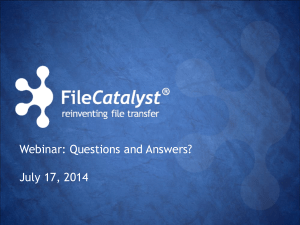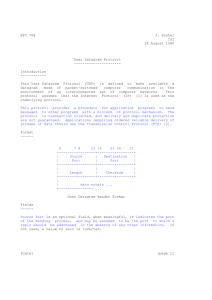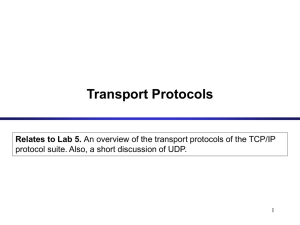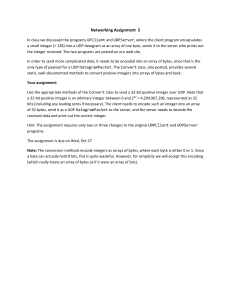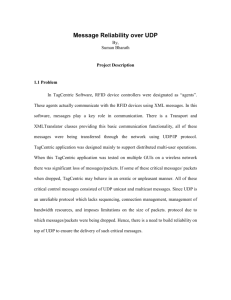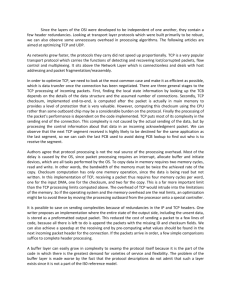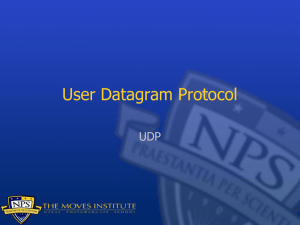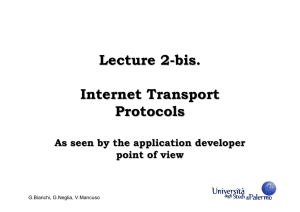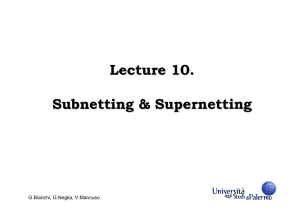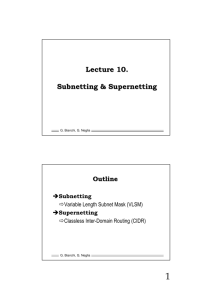Lecture 5. User Datagram Protocol (UDP)
advertisement
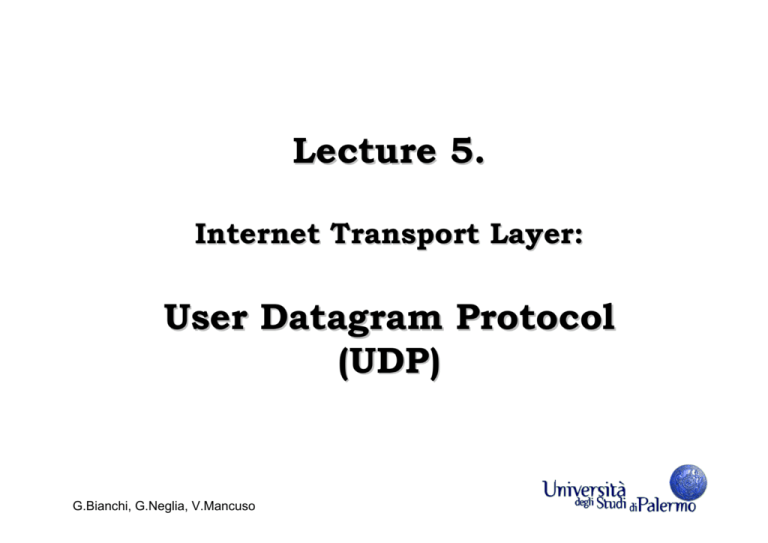
Lecture 5. Internet Transport Layer: User Datagram Protocol (UDP) G.Bianchi, G.Neglia, V.Mancuso Transport Layer Protocols Entire network seen as a pipe Internet G.Bianchi, G.Neglia, V.Mancuso ... UDP Packets ÎConnection-Less Ö (no handshaking) proc UDP IP proc UDP IP IP IP ÎUDP packets (Datagrams) IP Ö Each application interacts with UDP transport sw to produce EXACTLY ONE UDP datagram! UDP header Application Application data encapsulated in exactly 1 IP packet IP header UDP header Application data This is why, improperly, we use the term UDP packets G.Bianchi, G.Neglia, V.Mancuso UDP datagram format 8 bytes header + variable payload 0 7 15 23 source port destination port length (bytes) Checksum Data 31 ÎUDP length field Ö all UDP datagram Ö (header + payload) Îpayload sizes allowed: Ö Empty Ö Odd size (bytes) ÎUDP functions limited to: Öaddressing Æwhich is the only strictly necessary role of a transport protocol ÖError checking Æwhich may even be disabled for performance G.Bianchi, G.Neglia, V.Mancuso Maximum UDP datagram size Î16 bit UDP length field: Ö Maximum up to 216-1 = 65535 bytes Ö Includes 8 bytes UDP header (max data = 65527) ÎBut max IP packet size is also 65535 Ö Minus 20 bytes IP header, minus 8 bytes UDP header Ö Max UDP_data = 65507 bytes! ÎMoreover, most OS impose further limitations! Ö most systems provide 8192 bytes maximum (max size in NFS) Ö some OS had (still have?) internal implementation features (bugs?) that limit IP packet size ÆSunOS 4.1.3 had 32767 for max tolerable IP packet transmittable (but 32786 in reception…) – bug fixed only in Solaris 2.2 Î Finally, subnet Maximum Transfer Unit (MTU) limits may fragment datagram – annoying for reliability! Ö E.g. ethernet = 1500 bytes; PPP on your modem = 576 G.Bianchi, G.Neglia, V.Mancuso UDP: a lightweight protocol ÎNo connection establishment Öno initial overhead due to handshaking ÎNo connection state Ögreater number of supported connections by a server! ÎSmall packet header overhead Ö8 bytes only vs 20 in TCP Îoriginally intended for simple applications, oriented to short information exchange ÖDNS Ömanagement (e.g. SNMP) ÖDistributed file system support (e.g. NFS) Öetc G.Bianchi, G.Neglia, V.Mancuso Unregulated send rate in UDP ÖNo rate limitations ÆNo throttling due to congestion & flow control mechanisms ÆNo retransmission ÖLess overhead ÖIn contrast to TCP, UDP may provide multicast support Îextremely important features for today multimedia applications! Îspecially for real time applications which can tolerate some packet loss but require a minimum send rate. Be careful: UDP ok for multimedia because it does not provide anything at all (no features = no limits!). Application developers have to provide supplementary transport capabilities at the application layer! G.Bianchi, G.Neglia, V.Mancuso Audio/Video Support ÎUDP is transport layer candidate ÎUDP is too elementary! ÖNo sequence numbers ÖNo timestamp for resynchronization at receiver ÖNo multicasting ÎOld solution: let application developer build their own header ÎNew solution: use an enhanced transport protocol Real Time Protocol (RTP, RFC 3550) G.Bianchi, G.Neglia, V.Mancuso RTP: sublayer of Transport Application RTP UDP IP Lower layers G.Bianchi, G.Neglia, V.Mancuso Transport RTP as seen from Application Application RTP UDP IP Lower layers SOCKET INTERFACE Application developer integrates RTP into the application by: •writing code which creates the RTP encapsulating packets; •sends the RTP packets into a UDP socket interface. Details of RTP in subsequent courses – or see it in RFC 1889 G.Bianchi, G.Neglia, V.Mancuso Error checksum Î16 bit checksum field, obtained by: Ösumming up all 16 bit words in 7 15 23 31 header data and pseudoheader, in 0 Src port Dest port 1’s complement (checksum fields UDP length checksum filled with 0s initially) Ötake 1’s complement of result Data Öif result is 0, set it to 111111…11 (65535==0 in 1’s complement) 00000000 Îat destination: ÎZero padding Ö1’s complement sum should return Öwhen data size is odd 0, otherwise error detected Öupon error, no action (just packet Îchecksum disabled discard) Öby source, by setting 0 in the checksum field Îefficient implementation RFC 1071 G.Bianchi, G.Neglia, V.Mancuso disabling checksum ÎIn principle never! ÖRemember that IP packet checksum DOES NOT include packet payload. ÎIn practice, often done in NFS Ösun was the first, to speed up implementation Îmay be tolerable in LANs under one’s control. ÎDefinitely dangerous in the wide internet ÖExist layer 2 protocols without error checking Ösome routers happen to have bugs that modify bits G.Bianchi, G.Neglia, V.Mancuso Pseudo header ÎIs not transmitted! Ö it is information available at transmitter and at receiver Ö intention: double check that packet has arrived at correct destination and transport protocol Ö it violates protocol hierarcy! 0 7 15 23 Source IP address Destination IP address 00000000 protocol UDP length Source port Destination port UDP length checksum 31 12 bytes pseudoheader 8 bytes UDP header data Same checksum calculation used in TCP. UDP length duplicated. G.Bianchi, G.Neglia, V.Mancuso
